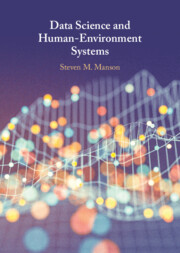Book contents
- Data Science and Human-Environment Systems
- Data Science and Human-Environment Systems
- Copyright page
- Contents
- Figures
- Tables
- Preface
- Acknowledgments
- 1 Data Science and Human-Environment Systems
- 2 Data Gaps and Potential
- 3 Big Methods, Big Messes, Big Solutions
- 4 Theory and the Perils of Black Box Science
- 5 Policy Dilemmas
- 6 Ways Forward for the Data Science of Human-Environment Systems
- References
- Index
- Plate Section (PDF Only)
2 - Data Gaps and Potential
Published online by Cambridge University Press: 02 February 2023
- Data Science and Human-Environment Systems
- Data Science and Human-Environment Systems
- Copyright page
- Contents
- Figures
- Tables
- Preface
- Acknowledgments
- 1 Data Science and Human-Environment Systems
- 2 Data Gaps and Potential
- 3 Big Methods, Big Messes, Big Solutions
- 4 Theory and the Perils of Black Box Science
- 5 Policy Dilemmas
- 6 Ways Forward for the Data Science of Human-Environment Systems
- References
- Index
- Plate Section (PDF Only)
Summary
For all the potential of big data and data science, scholars wanting to untangle human–environment interactions face many gaps in big data. Human-environment data handily exemplify many of the characteristics of big data. They have high volumes, orders of magnitudes more extensive than commonly used in most research fields, resulting from repeated observations over time and space (Jacobs 2009). These spatial and temporal data are often collected and analyzed across multiple scales. They exhibit high velocity, with data being collected and stored in or near real time from an extensive array of sensors at sea, on land, and in air and space, alongside data collected via social networks and internet sources. Human-environment data also exhibit incredible variety in the domains that they relate to and the structures and data models necessary to conduct research. They often represent complex social and biophysical entities and relationships that operate at multiple levels of an organization, over space, and through time. These data also push the boundaries of other characteristics, including value for answering specific questions and veracity in terms of accuracy and fitness for use.
- Type
- Chapter
- Information
- Data Science and Human-Environment Systems , pp. 27 - 75Publisher: Cambridge University PressPrint publication year: 2023

